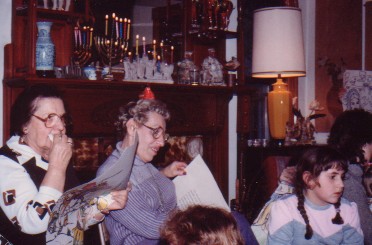|
● Religious
Liberty
● Rrotestants in the
United States
● CathoLics
● Three
Faiths
● Religious
Diversity
● American
Character of Religion
Three Faiths
 |
|
Passover
|
 Like
Catholics, Jews were a small minority in the first years of the
American republic. Until the late 19th century, most Jews in America
were of German origin. Many
of them belonged to the Reform movement, a liberal branch of
Judaism,
which had made many adjustments
to
modern life. Anti—Semitism,
or anti—Jewish prejudice, was not a big problem before the Civil
War. But when Jews began coming to America in great numbers, anti-Semitism
appeared. Like
Catholics, Jews were a small minority in the first years of the
American republic. Until the late 19th century, most Jews in America
were of German origin. Many
of them belonged to the Reform movement, a liberal branch of
Judaism,
which had made many adjustments
to
modern life. Anti—Semitism,
or anti—Jewish prejudice, was not a big problem before the Civil
War. But when Jews began coming to America in great numbers, anti-Semitism
appeared.
 |
|
A
Jewish Wedding
|
 Usually,
Jewish children attended public schools. The children of the immigrants
moved rapidly into the professions and into American universities,
where many became intellectual leaders. Many
remained religiously observant. Others, while they continued to
think of themselves as ethnically Jewish, adopted a secular, non—religious
outlook. Usually,
Jewish children attended public schools. The children of the immigrants
moved rapidly into the professions and into American universities,
where many became intellectual leaders. Many
remained religiously observant. Others, while they continued to
think of themselves as ethnically Jewish, adopted a secular, non—religious
outlook.
 When
faced with prejudice and discrimination, Jews responded by forming
organizations to combat prejudice. The
Anti—Defamation League played a major role in educating
Americans about the injustice of prejudice and making them aware
of the rights, not only of Jews, but of all minorities. When
faced with prejudice and discrimination, Jews responded by forming
organizations to combat prejudice. The
Anti—Defamation League played a major role in educating
Americans about the injustice of prejudice and making them aware
of the rights, not only of Jews, but of all minorities.
 By
the 1950s, a kind of “three faiths”model of the United States had
developed. Americans were considered to come in three basic varieties:
Protestant, Catholic and Jewish, the order reflecting the strength
in numbers of each group. But an increasing number of Americans
did not fit into any of these categories. And some who could be
considered Protestant had styles of life and beliefs that did not
fit into “Mainstream”America. By
the 1950s, a kind of “three faiths”model of the United States had
developed. Americans were considered to come in three basic varieties:
Protestant, Catholic and Jewish, the order reflecting the strength
in numbers of each group. But an increasing number of Americans
did not fit into any of these categories. And some who could be
considered Protestant had styles of life and beliefs that did not
fit into “Mainstream”America.
|

